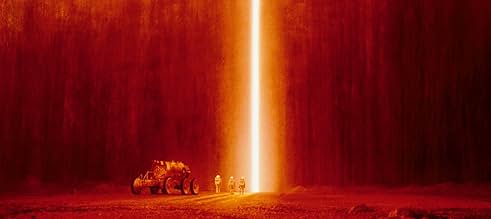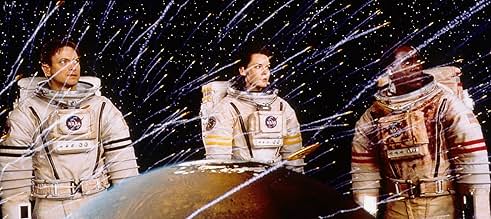Trotz minutiöser Vorbereitung und schärfster Sicherheitsvorkehrungen mündet die erste Mars-Mission in eine Katastrophe. Nun soll ein Rettungsteam nch möglichen Überlebenden und den genauen U... Alles lesenTrotz minutiöser Vorbereitung und schärfster Sicherheitsvorkehrungen mündet die erste Mars-Mission in eine Katastrophe. Nun soll ein Rettungsteam nch möglichen Überlebenden und den genauen Ursachen des Desasters suchen. Mit an Bord sind die NASA-Astronauten Woody Blake und Jim Mc... Alles lesenTrotz minutiöser Vorbereitung und schärfster Sicherheitsvorkehrungen mündet die erste Mars-Mission in eine Katastrophe. Nun soll ein Rettungsteam nch möglichen Überlebenden und den genauen Ursachen des Desasters suchen. Mit an Bord sind die NASA-Astronauten Woody Blake und Jim McConnell.
- Auszeichnungen
- 3 Nominierungen insgesamt
- Child at Party
- (as Jeff Ballard)
Empfohlene Bewertungen
I'm a sci-fi fan, and a scientist, so I was initially intrigued by the notion of a big-name dramatic film-maker doing a sci fi epic, which appeared, at least initially, to be hardcore sci-fi. By hardcore sci-fi, I mean fiction based on scientific reality, not fantasy with a tiny bit of science thrown in for decoration. An example, also using Mars as a vehicle, is Ben Bova's novel "Mars" - which focuses on the very edge of plausibility, only occasionally overstepping the bounds of scientific possibility. Film has rarely achieved this - a few interesting exceptions are Alien (the original), Outland and Silent Running. Hardcore sci-fi, which, I argue, this film could and should have been, is careful about that boundary. And 3/4ths of the way through Mission to Mars, it's still a hardcore sci-fi flick. Then suddenly, it's something else. I will leave that something else for you to discover, and stay focused on what the director and screenwriter were trying to do here.
What we have here is not really a single plot, but a pastiche of plots that have been strung together into one long, mysterious and grandiose story line. The film starts out with a couple of scenes which might have been lost in Appollo 13 - providing a little bit of character development and letting us know that we are about to witness the first manned space flight to Mars. That flight ends pretty quickly, as virtually everything goes wrong. And as a rescue mission begins, the question then becomes, why is everything going wrong? Up to the point where the rescue mission enters Martian orbit, this central question is sustained and developed skillfully, but then , in my opinion, things start to go wrong with the film itself.
There are major problems with what could have been the best aspects of this film. The spaceships are remarkably flimsy and poorly designed, but they look great! The safety protocols for the mission, about which we hear so much, are either not followed or incredibly naive. The heroes are not particularly clever about heroism, and seem to forget, at times, what the actual possibilities are for mobility in space (why not use the tether three times - twice out to Woody and once to get back after you run out of fuel, Terry?). The guy who authored the safety protocols does not appear particularly concerned with safety, or even protocols. The evolutionary biologist on the crew is amazingly poorly informed about the Paleozoic period of earth history and the evolution of species. I could go on.
The film is broadly derivative of 2001 A Space Oddyssey, The Abyss, Star Gate, Event Horizon, Fifth Element, Contact, and a few dozen other somewhat entertaining but not particularly believable space / sci-fi adventures, but while it resembles, and in fact pays homage to these films (especially 2001), it never entertains quite as well. Why? Because these films do not pretend to be based on scientific ideas, but rather, aesthetics and humanism. While most of these films invite interpretation, Mission to Mars simply repeats ideas from previous films and doesn't even bother to recast them into an interesting new light. Mission to Mars is something that has been done many times before, and in more interesting, entertaining, and thought-provoking ways.
Technical proficiency, which is something this film exudes, is no substitute for a compelling story and interesting individual characters. Unfortunately, even in terms of technique, the film has some flaws. Some will disagree, but I found the soundtrack irritating, and the pace of the film very uneven to say the least. And the characters lives are so intertwined in the few character development sequences that only Sinise, Robbins and Bennings' characters develop rudimentary individualities.
Despite his reputation, I can not hold Brian De Palma up to standards which are different than those of other film-makers, and I can not condone creating a special vocabulary or a sophisticated argument to permit interpretation of his films as part of some over-arching theme which only he and a few of his fans understand. There is a fine line between flattering imitation and shameless copying, so I'd rather not get into an extrapolated meta-film discussion of this film's relationship to 2001. I don't think this film is worthy of such a sophisticated analysis.
There are some truly great moments in Mission to Mars. This should not be too surprising with the wonderful cast, big budget, and talented production team. What did surprise me about this film was the 2001-like 180 degree turn it took off of the map of scientific possibility 3/4ths of the way through the film, and I can't say that turn and its outcome really impressed me.
If you're a sci-fi fan, or somebody with a very casual interest in science, you should probably see this. But if you haven't seen 2001 first, by all means, wait until you have. And don't take this one too seriously when you do get around to it. This has much more to do with fiction than science fiction.
I saw this movie in a cinema with my girlfriend - a Physics teacher. What we both liked was how it followed laws of physics - it was perhaps the first sci-fi we saw which showed properly how space works and what vacuum is all about.
I read in one review that the scene where they raise the USA flag is pathetic, when they should be running into the base to look for survivors; I disagree: Since they arrived nearly a year AFTER the incident, rushing doesn't make any sense.
I liked the "puzzle" part of the movie, as well as the final moments when the truth is revealed. Some laughed at that point, but I liked it a lot.
Remember how Space Odyssey plays with the idea that the intelligent life on Earth might be a product of "targetted imprinting"? Well, M2M suggests yet another possibility, and I find that extremely appealing.
The cast seemed brave to me: No top-class stars, no pretty faces, but instead good actors that are believable (after all, Garry Sinise played in Apollo 13 and Jerry O'Connell played a similar role in "The Sphere").
The film stars such veteran actors as Tim Robbins, Gary Sinise, Don Cheadle, and Jerry O'Connell; an ensemble where only first-class acting is possible. So let us move onto the direction. It is Brian DePalma's foray into science fiction. And masterfully done to say the least. His shot composition is reminiscent of Scarface and The Untouchables, mixing filmmaking from the days of yore with today's MTV aesthetic. DePalma's talent for filming suspenseful action sequences is in full swing in this film. The spacewalk scene will be one that will not be forgotten for quite some time. Could possibly be one of the best spacewalk scenes in films to date. The hidden jewel for me was the unpredictability of the film. Each corner turned was a pleasant surprise. I can't remember that last time I saw a movie with this quality, especially coming out of the Hollywood mainstream.
The cinematography was astounding. Imagine Lawrence of Arabia lensed on Mars. Professor Jenkins from Scientific America was correct when he said that the images from the film were identical to those photographed from the actual planet. And that is not a small feat.
Yes, the writing and acting are not amazing, not even great. It's average and below average at times, but the actors did their best and had some fun while filming.
I have a personal fascination with the nostalgic charm of 90s retro-futuristic spaceship interiors, from the decor and CGI to the overall aesthetics this film did Great.
The film has some great rolling shots that show off where the budget went. The visuals highlight the film's investment in creating a detailed and expansive portrayal of space and the Martian landscape, even if the CGI doesn't always hold up. These moments add to the film's aesthetic appeal, making the most of its visual potential despite other shortcomings in the narrative and character development.
The overall story takes a few twists and turns but keeps it simple and explains what is happening in a subtle manner.
I give this movie a 6/10.
Wusstest du schon
- WissenswertesThe filmmakers created the Martian landscape in a massive sandpit near Vancouver. It was one of the biggest sets ever constructed for a movie - around two million square feet.
- Patzer(at around 1h 18 mins) While looking at a DNA sequence Terri Fisher says that the last two chromosomes are missing. What is missing is actually the last two nucleotides of the sequence. DNA does not have chromosomes. Rather, chromosomes are comprised of DNA, and a single chromosome will contain many tens or hundreds of millions of nucleotides.
- Zitate
Terri Fisher: The genetic difference between men and apes is only three percent. But that three percent gave us Einstein, Mozart...
Phil Ohlmyer: ...Jack The Ripper.
- Crazy CreditsThe National Aeronautics and Space Administration's cooperation and assistance does not reflect an endorsement of the contents of the film or the treatment of the characters depicted therein.
- VerbindungenFeatured in Late Night with Conan O'Brien: Lisa Rinna (2000)
- SoundtracksMa 'Tit Fille
Written by Buckwheat Zydeco (as Stanley Dural, Jr.)
Performed by Buckwheat Zydeco
Courtesy of The Island Def Jam Music Group
By arrangement with Universal Music Special Markets
Top-Auswahl
Details
- Erscheinungsdatum
- Herkunftsländer
- Offizieller Standort
- Sprache
- Auch bekannt als
- Misión a Marte
- Drehorte
- Produktionsfirmen
- Weitere beteiligte Unternehmen bei IMDbPro anzeigen
Box Office
- Budget
- 100.000.000 $ (geschätzt)
- Bruttoertrag in den USA und Kanada
- 60.883.407 $
- Eröffnungswochenende in den USA und in Kanada
- 22.855.247 $
- 12. März 2000
- Weltweiter Bruttoertrag
- 110.983.407 $
- Laufzeit1 Stunde 54 Minuten
- Farbe
- Sound-Mix
- Seitenverhältnis
- 2.39:1
- 2.35 : 1
Zu dieser Seite beitragen

































